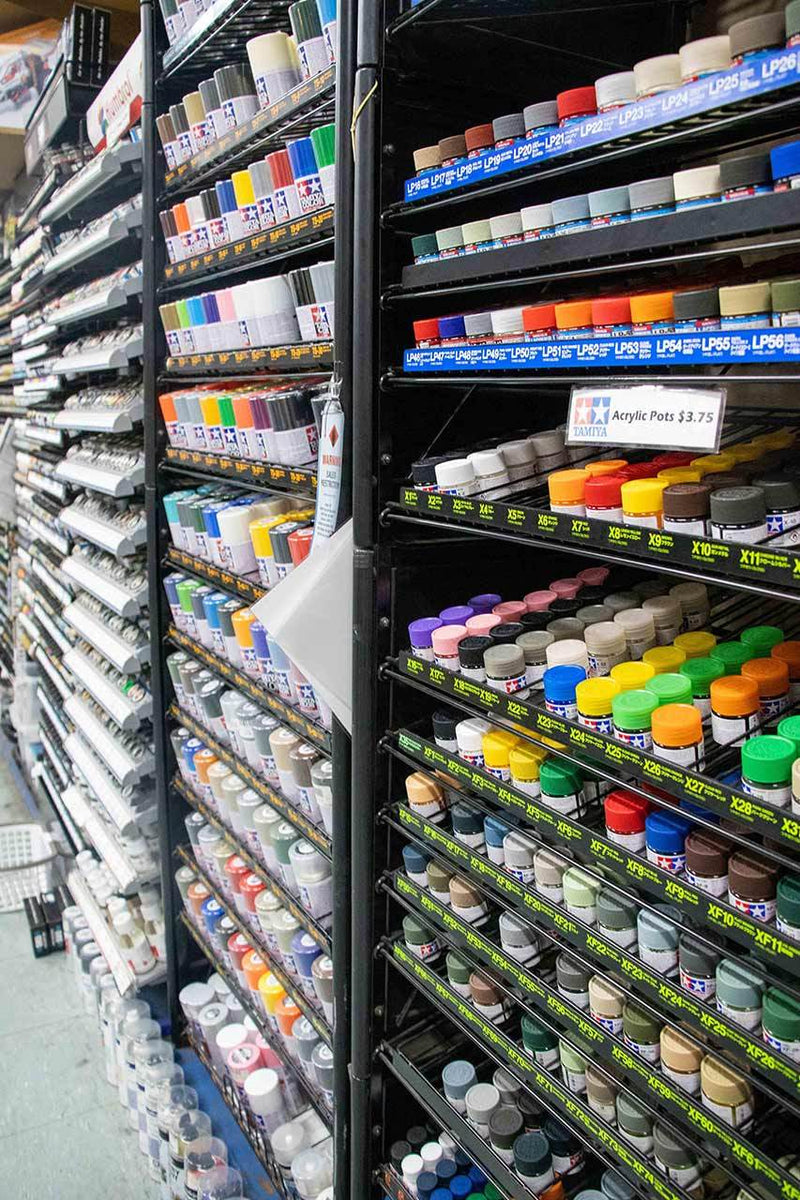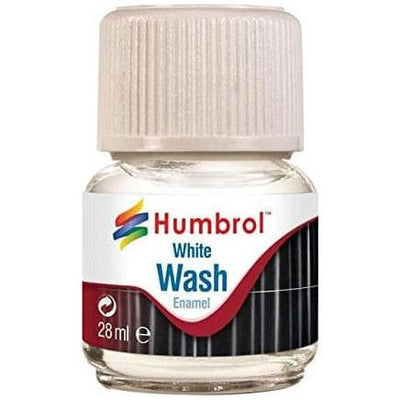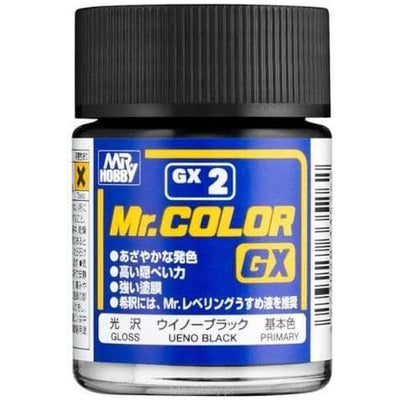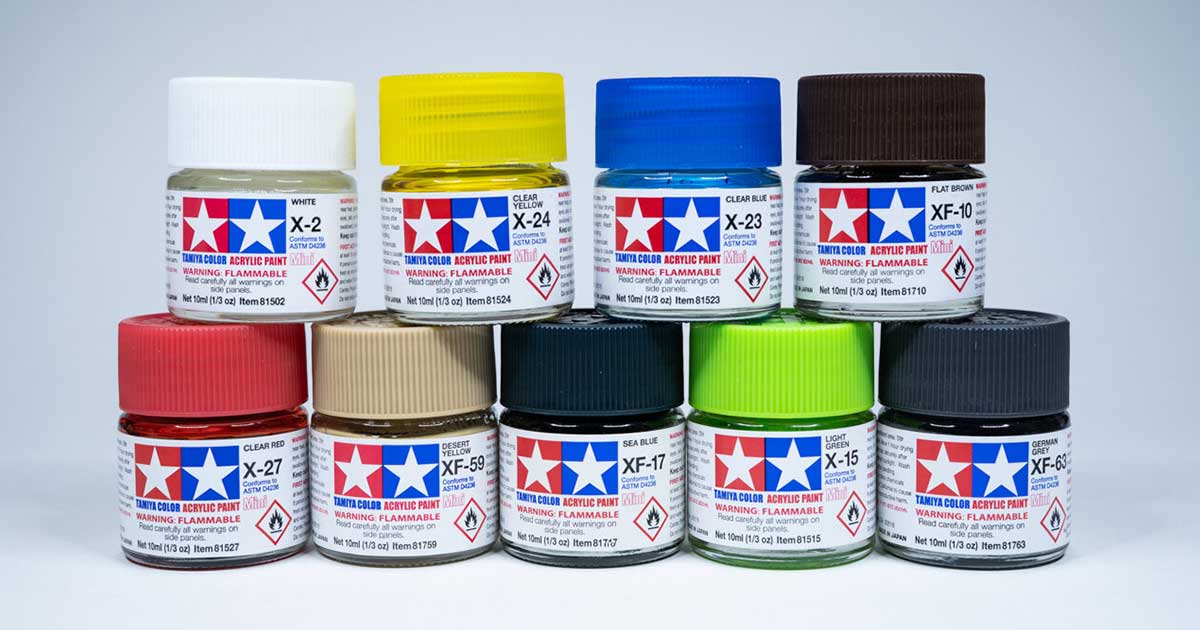Complete Guide to Hobby Paints: Which Type for Which Project
Master the art of model painting with the right tools for your craft
Achieving that perfect finish on your latest model or miniature project starts with selecting the right paint. Whether you're meticulously detailing a scale aircraft, bringing character to wargaming miniatures, or weathering a vintage car model, understanding the nuances between different hobby paints is crucial. At Hearns Hobbies, we offer an extensive range of specialist paints designed to help you achieve professional results, from versatile acrylics to durable enamels and high-gloss lacquers.
| Your Complete Hobby Paint Guide | |
|---|---|
| Paint Types Overview | Understanding acrylics, enamels, and lacquers |
| Surface Preparation | Essential primers and surface treatments |
| Application Methods | Brush techniques, airbrushing, and specialised effects |
| Finishing Touches | Weathering and protective finishes |
| Paint Selection | Choosing the right paint sets for your project |
What is Hobby Paint?
Hobby paints represent a specialised category of coatings engineered specifically for scale modelling, miniature painting, and craft projects. Unlike standard craft paints, these formulations feature ultra-fine pigments and precise viscosity control, enabling modellers to achieve exceptional detail and scale-appropriate finishes. When browsing our extensive paint collection, you'll discover that each type serves a unique purpose in the modeller's toolkit.
The distinguishing characteristics of hobby paints lie in their superior pigment density, scale-appropriate coverage, and exceptional adhesion properties. These specialised formulations are designed to work seamlessly with various materials, including plastic, resin, metal, and even traditionally challenging surfaces. Whether you're working with acrylics for their versatility, enamels for their durability, or lacquers for their pristine finish, each type offers distinct advantages for specific modelling applications.

Core Characteristics of Quality Hobby Paints
Understanding the fundamental properties of hobby paints is crucial for achieving professional results. High-quality formulations, available in our paint selection, offer several key advantages that set them apart from standard artistic or craft paints. These include exceptional pigment distribution, precise viscosity control, and scale-appropriate coverage that preserves the finest details of your models.
| Property | Benefit |
|---|---|
| Fine Pigmentation | Ensures smooth application and superior detail retention |
| Controlled Flow | Enables precise application with both brush and airbrush techniques |
| Surface Adhesion | Provides excellent grip on various modelling materials |
| Scale Consistency | Maintains appropriate thickness for scale model details |
Historical Context and Innovations in Hobby Paints
The evolution of hobby paints represents a fascinating journey of chemical innovation and artistic necessity. Beginning with traditional oil-based enamels in the early days of scale modelling, the industry has witnessed remarkable advancements in paint technology. Modern acrylic formulations now offer unprecedented versatility, while new lacquer technologies provide finishes that were once impossible to achieve at scale.
This progression has been driven by the demanding requirements of scale modelling, where accuracy and detail are paramount. Today's hobby paints benefit from advanced polymer science, resulting in improved pigment suspension, better flow characteristics, and enhanced durability. The introduction of specialised primers and weathering products has further expanded the possibilities for scale modellers and miniature artists.
The key to successful model painting lies in understanding these innovations and selecting the right paint for your specific project needs. Explore our comprehensive range of hobby paints to find the perfect match for your next masterpiece.
Types of Hobby Paints
Expert Tip:
Understanding the characteristics of different paint types is crucial for achieving the best results in your modelling projects. Each type excels in specific applications and techniques.
Acrylic Paints: Versatility and Ease of Use

Water-based acrylic paints have revolutionised the hobby painting world with their user-friendly characteristics and impressive versatility. These paints offer quick drying times, minimal odour, and excellent coverage, making them perfect for beginners and experienced modellers alike. Their water-soluble nature allows for easy cleanup and makes them particularly suitable for indoor use.
Key advantages of acrylics include:
- Rapid drying time enabling quick layering techniques
- Excellent compatibility with both brush and airbrush application
- Wide range of available colours and finishes
- Simple cleanup with water
Enamel Paints: Durability and Finish Quality
Enamel paints remain a favourite among serious modellers for their superior durability and exceptional finish quality. These oil-based formulations provide outstanding coverage and self-leveling properties, resulting in smooth, professional-looking surfaces. While they require more patience due to longer drying times, the results are often worth the wait.
Notable characteristics include:
- Superior durability and chip resistance
- Excellent for precise detail work and panel lining
- Perfect for creating realistic weathering effects
- Exceptional surface tension for smooth finishes

Lacquer Paints: Professional-Grade Finish

Lacquer paints represent the pinnacle of hobby paint technology, offering unmatched durability and a glass-like finish that's particularly popular in automotive and military modelling. These solvent-based paints create an incredibly tough surface that resists wear and environmental damage.
Distinguished features include:
- Ultra-smooth, high-gloss finish potential
- Exceptional durability and chemical resistance
- Rapid drying times for efficient project completion
- Superior adhesion to various surfaces
| Paint Type | Best For | Skill Level | Clean-Up |
|---|---|---|---|
| Acrylics | General modelling, beginners, indoor use | Beginner to Advanced | Water |
| Enamels | Detail work, weathering effects | Intermediate to Advanced | Mineral Spirits |
| Lacquers | Professional finishes, automotive models | Advanced | Lacquer Thinner |
Technical Insights
Understanding the technical aspects of hobby paints enables you to make informed decisions about which products will best suit your specific modelling needs.
Paint Composition and Quality
The effectiveness of hobby paints largely depends on their fundamental composition. High-quality paints from our extensive collection feature precisely milled pigments and carefully balanced binders. These components work together to ensure smooth application, consistent coverage, and lasting durability.
Critical factors affecting paint performance include:
| Component | Impact on Performance |
|---|---|
| Pigment Quality | Determines colour vibrancy, opacity, and coverage consistency |
| Binder Type | Affects adhesion strength and finish characteristics |
| Solvent Balance | Influences drying time and application properties |
Surface Preparation and Priming
Proper surface preparation is crucial for achieving professional results. Starting with the right primer creates an ideal foundation for your paint application. Different materials and paint types require specific preparation techniques:
Plastic Models
- Clean thoroughly with mild detergent
- Use appropriate plastic primer
- Sand between coats if necessary
Metal Surfaces
- Remove any oxidation
- Apply etching primer
- Consider rust prevention
Application Techniques and Tools
Mastering various application techniques enhances your ability to achieve desired effects. Whether you're using a brush or airbrush, proper technique is essential:
Brush Painting Techniques
- Base Coating: Apply thin, even coats using quality hobby paints
- Layering: Build up colours gradually for depth and transitions
- Dry Brushing: Use minimal paint for highlighting details
- Washing: Apply thin, diluted paint for shadow effects
Frequently Asked Questions
Which type of paint is best for beginners?
Acrylic paints are ideal for beginners due to their easy cleanup with water, quick drying time, and forgiving nature. They offer excellent coverage and can be easily thinned or mixed. Plus, their low odor makes them perfect for indoor use, and they're compatible with both brush and airbrush applications.
How do I prevent paint from peeling off plastic models?
To ensure proper paint adhesion on plastic models:
- Always clean the surface thoroughly to remove oils and debris
- Use appropriate primers designed for plastic
- Apply thin, multiple coats rather than one thick layer
- Allow adequate drying time between coats
- Consider light sanding between primer coats for better adhesion
Can I mix different types of hobby paints?
While it's generally best to stick within the same paint type:
- Acrylics should only be mixed with other acrylics
- Enamels can be mixed with other enamels
- Lacquers should only be combined with compatible lacquer paints
- Never mix water-based and solvent-based paints
- When in doubt, test on a spare surface first
What's the best way to thin hobby paints for airbrushing?
Each paint type requires specific thinning methods:
- Acrylics: Use proper acrylic thinner or distilled water
- Enamels: Use enamel thinners or mineral spirits
- Lacquers: Use only compatible lacquer thinners
- Aim for a milk-like consistency
- Test the mix on paper before applying to your model
Conclusion
Understanding and selecting the right hobby paints is fundamental to achieving professional-quality results in your modeling projects. Whether you choose the versatility of acrylics, the durability of enamels, or the superior finish of lacquers, each type offers unique advantages that can enhance your modeling experience.
Success in model painting comes from not just selecting the right paint, but also understanding proper surface preparation, application techniques, and the importance of using quality materials. By following the guidelines we've explored and practicing different techniques, you'll be well-equipped to tackle any painting project with confidence.
Final Thoughts:
Remember that mastering model painting is a journey of continuous learning and experimentation. Take time to understand your materials, practice different techniques, and most importantly, enjoy the creative process of bringing your models to life. Whether you're a beginner starting with acrylics or an experienced modeler working with lacquers, the key to success lies in patience, practice, and proper preparation.
 is here! Shop now, pay later in 4 easy installments
is here! Shop now, pay later in 4 easy installments

